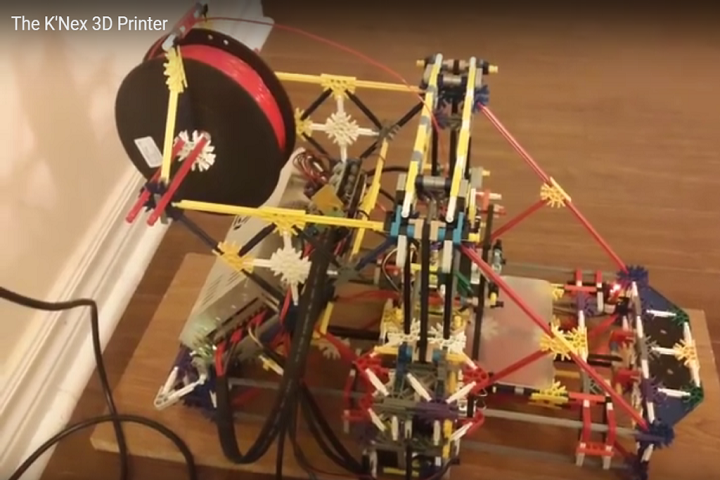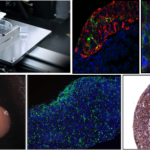

You can create just about anything with a 3D printer – but you can also create a 3D printer out of just about anything. It’s yet another thing that makes this technology unique, and one of the reasons it’s so popular with makers and DIY-ers. You may not be able to print liver tissue or jet engine parts on a 3D printer built out of Legos, but you can print plenty of other things on it (including chocolate, or more Legos). In fact, Legos aren’t the only old childhood toys that can be great raw materials for building working 3D printers. Remember K’Nex? They’re still around, and it turns out they can be used for much more than building models of molecules or lopsided cars.
Mohammed Al Aryan is a 19-year-old materials engineering student at McMaster University in Ontario, Canada. He first caught the 3D printing bug in his first-year engineering graphics and design course, where he used an Orion Delta 3D printer to print out gears for a project. He became fascinated by the technology and began regularly frequenting his local 3D Hubs until he decided it was time to get his own printer.
“I wanted to learn how they worked inside out, so I decided I would go for a DIY kit,” Al Aryan tells 3DPrint.com. “The Prusa Mendel i3 was what I was thinking of getting since there’s so much support for it already in the RepRap community. I looked through a couple of build tutorials and it was then that I realized that the frame could totally be built out of K’Nex. Doing so would save me some money and would be a fun challenge to take on. Quick searches through Google and YouTube didn’t show any solid examples of working 3D printers made out of K’Nex so I was even more motivated to build it.
We’ve seen a couple of 3D printers constructed from K’Nex, like this K’Nex/Lego hybrid and the Mec’Nex printer, which caught Al Aryan’s eye when he began researching his project. They’ve been very few and far between, however, as well as very experimental, and Al Aryan wanted to design something that would work as reliably as any commercial printer.

“I first tried out a couple of K’Nex designs and prototypes until I got a working model that had stable free moving X,Y and Z axis,” he tells us. “I then made a list of all the electronics I needed to get. I had to make sure the parts I ordered would be compatible with K’Nex. So I didn’t buy everything I needed at once. I would buy a few parts at a time and only when I was able to make it compatible with K’Nex would I buy more parts. This method was cost effective as I wouldn’t be left with a bunch of electronics I didn’t need had the project failed early on.”
The printer took Al Aryan about six months to complete – not bad considering that he had to wait about a month for the delivery of each parts order, while keeping up with his engineering studies at the same time. When his project was finished, he had a working (and colorful!) 3D printer with a build size of 56 x 36 x 31 cm and a print volume of 100 x 140 x 105 mm. The printer runs with Marlin firmware and Pronterface controller software, and Al Aryan also utilizes Slic3r to prepare his print jobs. Right now, he’s only tried printing with PLA at a speed of 40mm/s; he says that he may experiment with different speeds and/or materials in the future, but he wants to fine-tune the current print quality first.
Besides the K’Nex, other supplies Al Aryan used include 5 NEMA 17 stepper motors, a GeeeTech MK8 extruder with a 0.4 mm nozzle, and a 6”x 6” Fleks3D print bed. The total cost for building the printer ended up being a mere $250. So how did he feel about the finished product? Pretty good, as it turns out.
“There were several concerns I initially had, would I be able to properly mount an extruder onto K’Nex? and could K’Nex firmly hold NEMA 17 motors in stable positions? The answer was surprisingly yes to all and that is the beauty in K’Nex, there’s a thousand ways you can arrange these pieces,” Al Aryan concludes. “The trick is in figuring out which arrangement works best…Although it is not a printer I would yet use for professional prints, it’s still something I am really proud I was able to make. I learnt a lot through the process and had a great time working on it.”
You can see the printer in action below. What resourceful technology! Discuss in the 3D K’Nex Printer forum over at 3DPB.com.
If you're looking to get architectural 3D animation in the USA, our service provides an exceptional way to bring your architectural concepts to life through dynamic, immersive visuals. Through our platform, you can easily request high-quality 3D animations that showcase your designs in motion, offering a detailed view of your project from multiple angles and perspectives. Whether it's for a real estate development, a commercial building, or an urban planning project, our expert team ensures that every detail is captured in a visually compelling animation.
Through our website, you can seamlessly get architectural 3D animation tailored to your project’s specific needs. With our help, you can offer potential clients or investors an engaging experience that goes beyond static images. By integrating CGI animations with real-world settings, lighting, and textures, our team creates a lifelike experience that allows your audience to interact with your project as though it were already built. This service is perfect for presenting complex designs in a clear, visually attractive way that stands out in the competitive architectural market.




